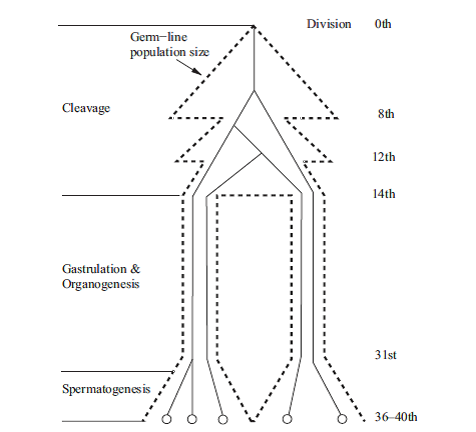Still want to say that organisms’ mutation rates during development are equal? Well, you may want think about it twice now. GAO JianJun (Kunming Institute of Zoology, CAS) and his colleges’ research results on PNAS (Sep. 2011, E-published ahead of print, www.pnas.org/cgi/doi/10.1073/pnas.1100233108) showed the U-shaped characteristics of germ-line development of male Drosophila melanogaster, which has the highest rate at the first cleavage, followed by a high rate at spermatogenesis, whereas most divisions in the middle have a mutation rate one or more orders of magnitude smaller.
Mutations of germ line cells have compound impacts on individuals and populations as they are inherited, while mutations that occur at early cell divisions will affect more tissues and are more likely to be transferred to the next generation. So, the timing and rate of mutation during development are critical for us to understand the relationship between genetic background and phenotype, which could eventually help to solve the eczemas of genetic disorders.
This 4-year project chose Drosophila melanogaster as the model organism based on its’ continuously studied, well understood germ cell population dynamics and the unprecedented mutation dataset in a well-controlled environment. Integrated with the framework of statistical inference, the number of mutations and the frequency of each independent mutation in each of 8,618 families have been observed and the differences of mutation rates at various stages as small as half of the maximum rate have been detected. The analyses show that (i) mutation rates (for recessive lethal or nearly lethal) are highly variable during germ cell development; (ii) first cell cleavagehas the highest mutation rate, which drops substantially in the second cleavage or the next few cleavages; (iii) the intermediate stages, after a few cleavages to right before spermatogenesis, have at least an order of magnitude smaller mutation rate; and (iv) spermatogenesis also harbors a fairly high mutation rate.
Those conclusions questioned the mainstream point of view and its’ inference, such as “male-driven evolution”, which were all based on the assumption that the mutation rate are equal. Furthermore, the statistical method adopted in this article may also be applied in the mutational patterns research of human germ line cells, somatic cells and tumor cells.

Fig.2. Illusion of the relationship of developmental stages, dynamics of population sizes, and genealogy of a sample of five spermatozoa. The last five cell divisions represent spermatogenesis, which may start as early as the 32nd division.
